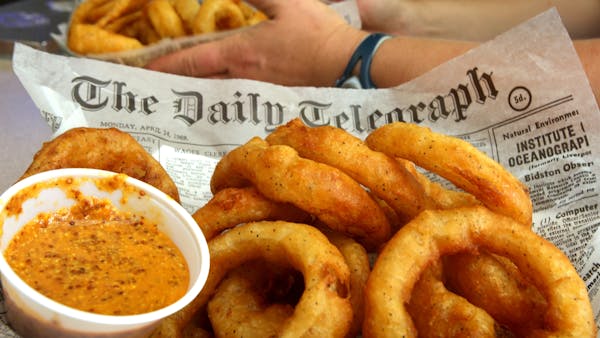As the Minnesota State Fair begins its 12-day run in Falcon Heights Thursday, it probably will be the last year for the popular Heritage Square exhibit area that has been part of the fair since 1975, welcoming folks looking for a nod to the past.
Next year, a newly discovered piece of that past, a gracefully arched metal sign built in 1933, then lost for 30 years, will greet people again as the new entrance to Heritage Square and a transit hub. It's part of the fair's effort to balance long-treasured traditions with staying relevant to changing needs and new audiences, said Jerry Hammer, executive vice president of the fair.
"I don't know any other place that [values its past] like the State Fair does,'' he said. "We try to hang onto these things. The things that tie us to the past tie us to the future."
Trying to please the 1.7 million visitors to the Great Minnesota Get Together is a challenge as tall as the Space Tower.
Part of the fair's appeal is that it doesn't change drastically, said Larry Millett, a writer and noted architectural historian, author of "Lost Twin Cities." Because the fair is once a year, and there's a desire for continuity, changes at the fairgrounds tend to evolve slowly, he added.
The two oldest buildings on the grounds, the Fine Arts Center and the Progress Center, date to 1907. "Your great-grandparents went there, maybe your great-great grandparents, if they were here," Hammer said.
Preservation projects at the fair are a constant: the grandstand, built in 1909 to replace one built in 1885, was refurbished 10 years ago at a cost of $18 million, then the livestock barns and the International Bazaar.
If the 2013 fair goes well, plans — in the works for about 20 years — call for Heritage Square to be replaced with a vibrant new area that will include many of the same exhibits and attractions.
When changes like those envisioned for Heritage Square are planned, response can be mixed. "People in Minnesota have a very possessive sense about their fair," Millett said.
The appeal of Heritage Square, built as a temporary exhibit, may be its familiarity. It hardly ranks with the fair's architectural treasures, he said, which include almost every major style of the 20th century.
"People don't go there for the architecture, but it's there," Millett said.
Instead of being on the periphery of the fairgrounds, the new Heritage Square will still be west of the grandstand but nestled between the midway and a new transit center, and the new gate that is created is expected to become the fair's busiest, Hammer said.
Which leads back to the metal arch.
Radical incarnations of stick-borne food aside, the fair is festooned with tangible ties to the past, and the arch will become one of them as part of the Heritage Square/transit center refurbishing.
The metal arch was fabricated 80 years ago by workers with the Federal Emergency Relief Administration, one of the economic recovery programs created by President Franklin Roosevelt's New Deal, Hammer said. It was mounted on two brick pillars, and was set back from Como Avenue — that's because it stood at the end of the streetcar run that brought thousands to the fair. The bright white sign with brilliant blue letters bid them welcome.
The streetcars would come from the east and west off Como and loop into the grounds — one coming from St. Paul, the other from Minneapolis. A switching area took up a chunk of the grounds.
In the early 1980s, when the Wild River Ride was installed, the pillars were demolished, and the sign was hauled to an out-of-the-way corner of the grounds south of the Como Avenue parking lot near some railroad tracks. Last fall, Hammer said, a worker with the Metropolitan Mosquito Control District stumbled across it in the underbrush. "When it was set there, there wasn't anything around it — but that was 30 years ago," Hammer said.
The worker contacted St. Paul Pioneer Press columnist Joe Soucheray, who in turn contacted Hammer and championed its restoration. Not that Hammer needed convincing.
The sign was carefully moved and brought to a metalworks business in Hugo, where it was sandblasted and refurbished — it was actually in pretty good shape, Hammer said. It is now primed and ready for painting, and will be on display this year next to the ShenaniGuns Comedy Wild West Show at the northeast corner of Heritage Square. The project could cost $25,000 when complete.
"There might be some kind of cosmic State Fair sensibility or something that the arch happened to pop up just as we were talking about a transit hub," he said. "We have more people every year taking transit to the fair, just like the old days. We've come full circle."
The Como parking lot is serviceable, but it isn't efficient and forces people to cross Como Avenue. That won't be the case next year if plans fall into place. And the arch will be placed front and center once again.
The only decision left is what to paint on the sign, Hammer said.
Historic photos show it saying simply "State Fair," but when it was found, it said "Minnesota State Fair."
"I want to find out what it said originally, when it was brand new," Hammer said. "You really don't have to say Minnesota State Fair when you're here, do you?"
Jim Anderson • 651-925-5039 Twitter: @StribJAnderson

Minneapolis schools, teachers reach tentative agreement to avert strike
Men knock woman down and steal her dog during walk, St. Paul police say

Minneapolis reaches $150k settlement with eyewitness of George Floyd's murder
He grew up legally in Minnesota, but immigration law gap may one day force student to leave

